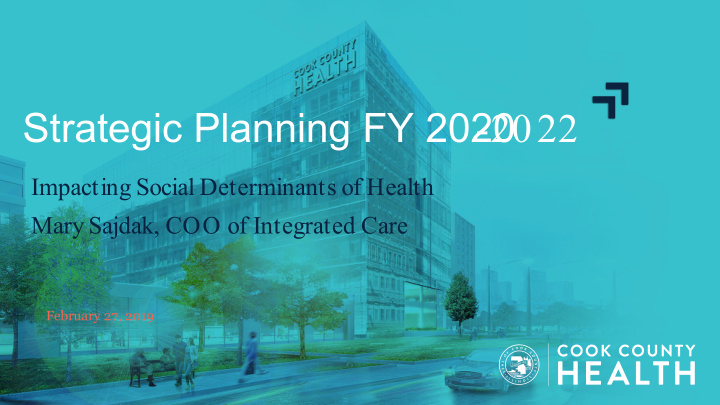



Strategic Planning FY 2020 -2022 Impacting Social Determinants of Health Mary Sajdak, COO of Integrated Care February 27, 2019
Impact 2020 Recap Status and Results • Deliver High Quality Care • Grow to Serve and Compete • Foster Fiscal Stewardship Invest in Resources • • Leverage Valuables Assets • Impact Social Determinants • Advocate for patients
Impact 2020 Progress and Updates-Social Determinants of Health Name Status Ensure continued access • Director of Carelink hired 11/18 for uninsured patients Monthly meetings with joint agenda settings established • • Carelink membership stable at 31,500 • # of Carelink members in Care Coordination 326 • Understanding admission reasons, ambulatory visits to refine care coordination approach CCDPH data to plan In Progress intervention to improve population health 3
Impact 2020 Progress and Updates-Social Determinants of Health Name Status Partner with other • Food as Medicine Greater Chicago Food Depository food trucks at organizations to impact 13 sites social determinants of • Contract in process for nutritional support for at-risk CCH patients and health CountyCare members with Independent Living Systems • Partnership established with Black Oaks , planning for 2019 underway • Completed housing 33 units for Housing Forward , 30 for Illinois Housing Development Authority (IHDA) • Training for care coordination for Coordinated Entry System and assessments • Securing 56 vouchers for Housing Authority for Cook County (HACC) Outreach started on Flexible Housing Pool initiative • Develop Care Developed, 200 care coordination team members in multiple sites Coordination 4
Additional Activities -Linked to Social Determinants Focus Area Activities Results Linkages to • Specialized discharge planning for those with • 60 patients per month Mental Health medical complications of Opioid Use Disorder • 500 to 600 BHAL referrals per (MH)/Substance (OUD) month to ambulatory providers Use Disorder Access to outpatient services via Behavioral Health Approximately 80 referrals per • • (SUD) Services Access Line (BHAL) month to MH and SUD providers Warm hand-offs for those in pretrial area at 26 th and • California with MH/SUD Access to care • Additional support for Patient Support Center • 277,279 primary and specialty care through Chicago Lighthouse appointments were made in in 2018. (30,011 Chicago Lighthouse) • Initiation of concierge services for patients Social Support • Utility Assistance • $180,000 in grants, average grant • Expansion of Community Health Worker activities size $250 to $500. of linkages to community based organizations 5
Additional Activities Underway Focus Area Activities Results Income/Economic Legal Aid Foundation support 2018 Referrals • Support to resolve Health Harming 256 Public Benefits Needs 44 Housing • Access to public benefits 36 Family Law • Application for SSI and 80 ADAPT SSDI 22 Disability Cases (SSI/SSDI) Transit • Rides for discharged patients, 110,000 rides since 9/17 ED patients, ACHN and 95% on time arrival methadone 27.4 minutes for on-demand rides 8821 bus passes for methadone treatment 6
Social Determinants Facilitators • A funding stream to enable this work this includes system resources as well as grant funds • Health System willingness to engage for non- traditional service/support • Staff willing to tackle the complexities associated with this work • Willing external and internal partners 7
Health Risk Screening
Health Risk Screening Identification Screening for Social Determinants of Health • ED, Inpatient Units, Ambulatory Centers, Bond Court Referrals from staff, physicians, CountyCare Data review -- claims, utilization information Results • 17,093 CountyCare members were screened during 2018 9
Health Risk Screening Self-Reported Data Question Potential Risk Question Potential Risk Factor Last PCP visit >1 yr (5%) Abuse history (3%) Lack of transportation (20%) Afraid of family (.6%) for medical appts member Problems obtaining or (9%) No one to help you for a (26%) paying for meds few days Overall health Fair (22.6) Need help getting food (18%) Poor (8.6%) Presence of MH (17.1%) Help with housing (10.9%) condition Presence of SUD (2.9%) Help with utilities (15.3%) Unstable Living Situation (2.0%) Help with clothing (12.1%) 10 10
Health Risk Screening Frequency of Risk Indicators 1-3 Indictors % 4-6 Indicators 7 or more Population Size % Indicators % Chronic MH 43.3 % 39.7% 16.8% 2,446 Chronic SUD 26.4% 43.0% 30.4% 702 MH/SUD 16.0% 40.8% 43.0% 411 Total Population 80.4% 16.0% 3.5% 17,093 11 11
FY2020 -2022 Opportunities
Impact Social Determinants/Advocate for Patients FY 2020-2022 Strategic Planning Recommendations 2018 Opportunities • External partnerships are only partially defined; not clear how well they work/support the patients or members • Engagement of physicians and medical home team members regarding CCH capabilities • Being able to evaluate what really works for whom 13 13
Impact Social Determinants/Advocate for Patients FY 2020-2022 Strategic Planning Recommendations Integrated Care Short-Term Plans • Meet or exceed targets for all funded projects related to housing, opioid abuse, linkages to treatment for SMI • Secure ongoing funding for MH/SUD activities when grant funding expires e.g. recovery coaches, AOT Assisted Outpatient Treatment (AOT) program, etc. • Catalog existing activities regarding tobacco cessation, nutritional support, exercise and risk reduction for scalability and ease of referrals • Identify top 3 social/community needs of CCH supported patients and identify strategy(ies) to meet needs • Partner with CCDPH on one mutual project (housing for children at risk) • Develop an understanding of patient approach and related successful interventions • Develop and present a housing model for CCH patients 14 14
Impact Social Determinants/Advocate for Patients FY 2020-2022 Strategic Planning Recommendations Organizing for Impact and Sustainability • Create a coordinating committee -- success will depend on cross-department collaboration and coordination • Identify working definitions for social determinants of health, which ones may be in the purview of CCH departments and strategies for others that may have significant impact • Complete gap analysis and provide recommendations • Document resource requirements, training etc. • Enter into discussions to support collaboration • Review information from cataloging existing programs and determine next steps • Complete implementation of social service data base 15 15
Thank You
Recommend
More recommend